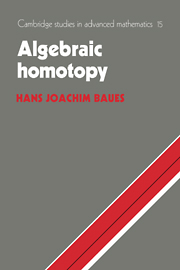Book contents
- Frontmatter
- Contents
- Preface
- Introduction
- List of symbols
- I Axioms for homotopy theory and examples of cofibration categories
- II Homotopy theory in a cofibration category
- III The homotopy spectral sequences in a cofibration category
- IV Extensions, coverings, and cohomology groups of a category
- V Maps between mapping cones
- VI Homotopy theory of CW-complexes
- VII Homotopy theory of complexes in a cofibration category
- VIII Homotopy theory of Postnikov towers and the Sullivan–de Rham equivalence of rational homotopy categories
- IX Homotopy theory of reduced complexes
- Bibliography
- Index
Preface
Published online by Cambridge University Press: 22 March 2010
- Frontmatter
- Contents
- Preface
- Introduction
- List of symbols
- I Axioms for homotopy theory and examples of cofibration categories
- II Homotopy theory in a cofibration category
- III The homotopy spectral sequences in a cofibration category
- IV Extensions, coverings, and cohomology groups of a category
- V Maps between mapping cones
- VI Homotopy theory of CW-complexes
- VII Homotopy theory of complexes in a cofibration category
- VIII Homotopy theory of Postnikov towers and the Sullivan–de Rham equivalence of rational homotopy categories
- IX Homotopy theory of reduced complexes
- Bibliography
- Index
Summary
This book gives a new general outlook on homotopy theory: fundamental ideas of homotopy theory are developed in the presence of a few axioms so that they are available in a broad variety of contexts. Many examples and applications in topology and algebra are discussed; we consider the homotopy theory of topological spaces, the algebraic homotopy theory of chain algebras, and rational homotopy theory.
The axiomatic approach saves a lot of work in the various fields of application and offers a new way of organizing a course of modern homotopy theory. A fruitful interplay takes place among the various applications.
This book is also a research monograph on homotopy classification problems. The main new result and our principal objective is the ‘tower of categories’ which approximates the homotopy category of complexes. Such towers turn out to be a useful new tool for homotopy classification problems; they complement the well-known spectral sequences. The theory on complexes is a continuation of J.H.C. Whitehead's combinatorial homotopy. In fact, some of Whitehead's results can be derived readily from the properties of the towers.
In a later chapter (Chapter IX) we describe the simplest examples of towers of categories from which nevertheless fundamental results of homotopy theory can be immediately deduced.
Most of the material in the book does not appear in any textbook on algebraic topology and homotopy theory.
As prerequisites the reader should be familiar with elementary topology and the language of categories.
- Type
- Chapter
- Information
- Algebraic Homotopy , pp. xi - xiiPublisher: Cambridge University PressPrint publication year: 1989

